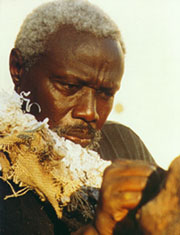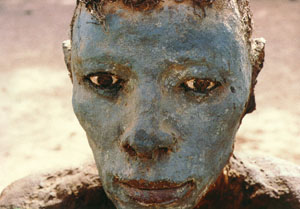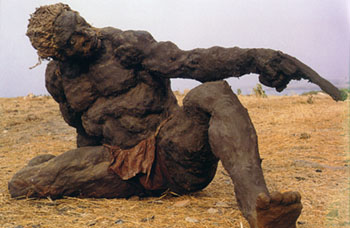by Florence Charpigny
The scene: Pont des Arts, in Paris, with the Louvre in the background. On the bridge, braving the cold and rain, an attentive crowd
festooned with cameras: smiling, listening to the young man singing George Brassens songs, and joining in the choruses; pausing nonchalantly by the painter painting the Seine. And, most of all, watching, observing,
remarking on and reacting to the scenographies of Ousmane Sow. There are 68 sculptures in all. Modelled characters and animals, literally larger
than life, arranged in groups, each telling a story: Nouba wrestlers in a clinch, Masai warriors and shepherds, Peuls shepherds and villagers going about their business, Two Moon and his Cheyenne tribe, Gall and his Sioux repelling
General Custer's Seventh Company at Little Big Horn. Each scene, each detail, the whole collection, is self-evident and singular, compelling the gaze with the
dazzlingly expressive faces and attitudes, the fierce, lavish anatomies... Indeed this is what makes Ousmane Sow's œuvre unsettling, thought-provoking: the
emotion one feels and the attraction it arouses derive from the intermingling histories of the Dakar sculptor and his European audience.
"Fierce anatomy"! Deep down, doesn't writing this refer to the myth of the savage, and not a very good myth it is; doesn't gossiping about the unerotic nudity of the Nouba wrestlers summon what is so-called original purity? In these scenes of African tribes' daily life, one could also see Ousmane Sow's intention to testify or even, like the African griot, a travelling poet and musician, to pass on the pieces of a tradition, of a culture, or, as the French would say, of a fragile heritage. But the artist said himself that his interest in the Nouba was fostered by the photographs of the highly controversial Leni Riefensthal, and that he has never met any Zulus or Masai. In fact, one would probably be quite wrong to consider Ousmane Sow's work as an ethnological survey; to do so would prompt one to wonder naively about the point of Little Big Horn, which does not stem from his culture and yet which he treats just as happily.
Sow's œuvre goes far beyond testimony and description; to my mind, he achieves a universal dimension. The issue is not whether he is part of the European or African artistic tradition; it is about delving into the means that produce such an extraordinary effect, and particularly the dreadful aesthetics of the violence constantly staged: the gentle violence of the scarring scenes, the ritualised violence of the wrestling scenes, the murderous violence of the battlefield. There is in the anatomies and postures of the fighters and horses of Little Big Horn, shaped quite literally like exposed flesh, something of Géricault, an epic sweep that captures the movement and the sentiment but transcends the violence without considering it sacred. By avoiding the representation of wounds and blood, Ousmane Sow produces an image of universal symbolism.
Is the slightly enclosed space on the bridge, cramping the work, to be regretted? Certainly not, because it is neither a reconstruction nor a trompe-l'œil, but rather a silent, stationary play that helps one understand.
Ousmane Sow on the Pont des Arts, Paris
Next exhibition in december 1999 - Lyon, Le Rectangle (Place Bellecour)
until May 20th 1999
www.paris-france.org
Translated by Paul Jones
Ph. B. Soulé


